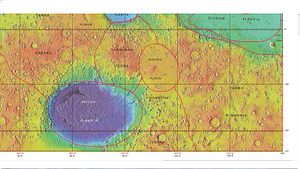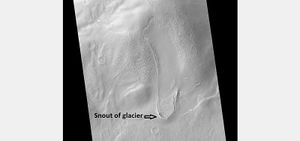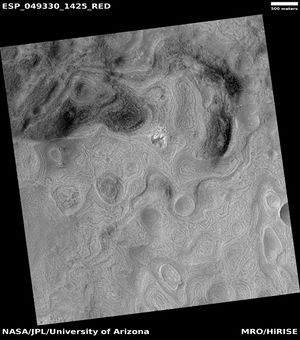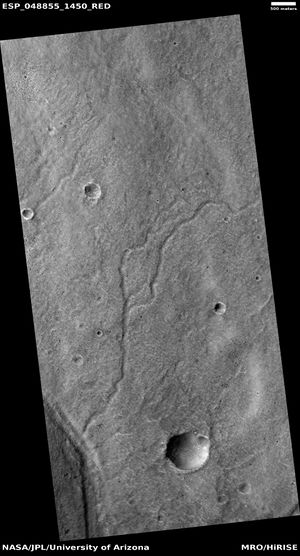Difference between revisions of "Hellas Planitia"
(tried to add image) |
Suitupshowup (talk | contribs) (→Honeycomb Terrain: added ref) |
||
| (19 intermediate revisions by 3 users not shown) | |||
| Line 1: | Line 1: | ||
| + | {{Mars atlas}} | ||
| + | |||
[[Image:Hellas_basin.jpg|right|thumb|300px|A Mars Orbiter Laser Altimeter (MOLA) image (onboard the [[Mars Global Surveyor]] orbiter) of '''Hellas Planitia'''.]] | [[Image:Hellas_basin.jpg|right|thumb|300px|A Mars Orbiter Laser Altimeter (MOLA) image (onboard the [[Mars Global Surveyor]] orbiter) of '''Hellas Planitia'''.]] | ||
| − | '''Hellas Planitia''' is a vast [[meteorites|meteorite]] impact basin located at 42° 42'S 70° 00'E, in the [[Mars]] southern hemisphere. Also known as the '''Hellas Impact Basin''', this landmark has a very obvious impact [[crater]] ring 2,300 km (1,400 mi) in diameter. This is one of the largest known impact craters in the [[solar system]].<ref>[http://en.wikipedia.org/wiki/Hellas_Basin Hellas Basin article on Wikipedia]</ref><ref>[http://en.wikipedia.org/wiki/Impact_crater#Largest_named_craters_in_the_Solar_System Impact Craters on Wikipedia]</ref> | + | |
| + | [[Image: Hellasplanitiamap.jpg|left|thumb|300px|Map showing locations of Hellas Planitia and other nearby regions]] | ||
| + | |||
| + | '''Hellas Planitia''' is a vast [[meteorites|meteorite]] impact basin located at 42° 42'S 70° 00'E, in the [[Mars]] southern hemisphere. Hellas Planitia is in the Hellas quadrangle and the Noachis quadrangle. It's name is a classic feature name that refers to the country of Greece.<ref> MacDonald, T. 1971. The Origins of Martian Nomenclature. Icarus: 15, 233-240</ref> The name was officially approved in 1973.<ref>https://planetarynames.wr.usgs.gov/Page/MARS/target</ref> | ||
| + | Also known as the '''Hellas Impact Basin''', this landmark has a very obvious impact [[crater]] ring 2,300 km (1,400 mi) in diameter. This is one of the largest known impact craters in the [[solar system]].<ref>[http://en.wikipedia.org/wiki/Hellas_Basin Hellas Basin article on Wikipedia]</ref><ref>[http://en.wikipedia.org/wiki/Impact_crater#Largest_named_craters_in_the_Solar_System Impact Craters on Wikipedia]</ref> | ||
| + | |||
| + | Radar images by the Mars Reconnaissance Orbiter (MRO) spacecraft's SHARAD radar sounder suggest that features called lobate debris aprons in at least some craters in the eastern region of Hellas Planitia are actually glaciers of water ice lying buried beneath thin layers of dirt and rock.<ref>http://photojournal.jpl.nasa.gov/catalog/?IDNumber=pia11433|title=PIA11433: Three Craters|accessdate=2008-11-24|author=NASA</ref> Scientists believe that snow and ice accumulated on higher topography, flowed downhill, and is now protected from sublimation by a layer of rock debris and dust. Sublimation is when a solid changes directly to a gas without passing through a liquid phase. So on Mars, water ice will go directly into a vapor phase. This is common on Mars because of its thin atmosphere. Furrows and ridges on the surface were caused by deforming ice. | ||
| + | |||
| + | Also, the shapes of many features in Hellas Planitia and other parts of Mars are strongly suggestive of glaciers, as the surface looks as if movement has taken place. | ||
| + | [[Image: Tongue23141 1435.jpg|right|thumb|300px|Tongue-shaped glacier in Hellas Planitia]] | ||
| + | |||
| + | Note: More information about various features like glaciers that contain water ice are found in [[Martian features that are signs of water ice]]. | ||
| + | |||
| + | ==Honeycomb Terrain== | ||
| + | |||
| + | Honeycomb terrain bears shapes similar to a honeycomb. This “honeycomb” terrain was first discovered in the northwestern part of the floor of Hellas.<ref>cite journal | last1 = Bernhardt | first1 = H. | display-authors = etal | year = 2016 | title = The honeycomb terrain on the Hellas basin floor, mars: a case for salt or ice diapirism: hellas honeycombs as salt/ice diapirs | url = | journal = J. Geophys. Res. | volume = 121 | issue = | pages = 714–738 | doi=10.1002/2016je005007| </ref> The geologic process responsible for creating these features remains unresolved.<ref>http://www.uahirise.org/ESP_049330_1425</ref> <ref>https://www.uahirise.org/hipod/ESP_085926_1410</ref> Some calculations indicate that this formation may have been caused by ice moving up through the ground in this region. The ice layer would have been between 100 m and 1 km thick.<ref>Weiss, D., J. Head. 2017. HYDROLOGY OF THE HELLAS BASIN AND THE EARLY MARS CLIMATE: WAS THE HONEYCOMB TERRAIN FORMED BY SALT OR ICE DIAPIRISM? Lunar and Planetary Science XLVIII. 1060.pdf</ref><ref>cite journal | last1 = Weiss | first1 = D. | last2 = Head | first2 = J. | year = 2017 | title = Salt or ice diapirism origin for the honeycomb terrain in Hellas basin, Mars?: Implications for the early martian climate | url = | journal = Icarus | volume = 284 | issue = | pages = 249–263 | doi=10.1016/j.icarus.2016.11.016 |</ref> <ref>Bernhardt, H.; et al. (2016). "The honeycomb terrain on the Hellas basin floor, mars: a case for salt or ice diapirism: hellas honeycombs as salt/ice diapirs". J. Geophys. Res. 121: 714–738.</ref> So, it seems that large masses of ice have pushed up layers of rock into domes that were eroded. After erosion removed the top of the layered domes, circular features remained that look like the cells in a honeycomb. | ||
| + | |||
| + | [[Image: ESP 049330 1425honeycomb.jpg|center|thumb|300px|Honeycomb terrain on floor of Hellas Basin]] | ||
| + | |||
[[Image: ESP 048855 1450channels.jpg|right|thumb|300px|Channels in Hellas quadrangle]] | [[Image: ESP 048855 1450channels.jpg|right|thumb|300px|Channels in Hellas quadrangle]] | ||
| − | |||
===References:=== | ===References:=== | ||
<references/> | <references/> | ||
| − | [[ | + | |
| − | + | [[Category:Mars Atlas]] | |
| + | |||
Latest revision as of 05:03, 25 April 2025
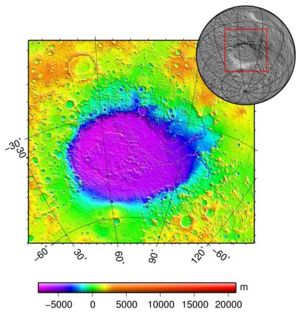
Hellas Planitia is a vast meteorite impact basin located at 42° 42'S 70° 00'E, in the Mars southern hemisphere. Hellas Planitia is in the Hellas quadrangle and the Noachis quadrangle. It's name is a classic feature name that refers to the country of Greece.[1] The name was officially approved in 1973.[2] Also known as the Hellas Impact Basin, this landmark has a very obvious impact crater ring 2,300 km (1,400 mi) in diameter. This is one of the largest known impact craters in the solar system.[3][4]
Radar images by the Mars Reconnaissance Orbiter (MRO) spacecraft's SHARAD radar sounder suggest that features called lobate debris aprons in at least some craters in the eastern region of Hellas Planitia are actually glaciers of water ice lying buried beneath thin layers of dirt and rock.[5] Scientists believe that snow and ice accumulated on higher topography, flowed downhill, and is now protected from sublimation by a layer of rock debris and dust. Sublimation is when a solid changes directly to a gas without passing through a liquid phase. So on Mars, water ice will go directly into a vapor phase. This is common on Mars because of its thin atmosphere. Furrows and ridges on the surface were caused by deforming ice.
Also, the shapes of many features in Hellas Planitia and other parts of Mars are strongly suggestive of glaciers, as the surface looks as if movement has taken place.
Note: More information about various features like glaciers that contain water ice are found in Martian features that are signs of water ice.
Honeycomb Terrain
Honeycomb terrain bears shapes similar to a honeycomb. This “honeycomb” terrain was first discovered in the northwestern part of the floor of Hellas.[6] The geologic process responsible for creating these features remains unresolved.[7] [8] Some calculations indicate that this formation may have been caused by ice moving up through the ground in this region. The ice layer would have been between 100 m and 1 km thick.[9][10] [11] So, it seems that large masses of ice have pushed up layers of rock into domes that were eroded. After erosion removed the top of the layered domes, circular features remained that look like the cells in a honeycomb.
References:
- ↑ MacDonald, T. 1971. The Origins of Martian Nomenclature. Icarus: 15, 233-240
- ↑ https://planetarynames.wr.usgs.gov/Page/MARS/target
- ↑ Hellas Basin article on Wikipedia
- ↑ Impact Craters on Wikipedia
- ↑ http://photojournal.jpl.nasa.gov/catalog/?IDNumber=pia11433%7Ctitle=PIA11433: Three Craters|accessdate=2008-11-24|author=NASA
- ↑ cite journal | last1 = Bernhardt | first1 = H. | display-authors = etal | year = 2016 | title = The honeycomb terrain on the Hellas basin floor, mars: a case for salt or ice diapirism: hellas honeycombs as salt/ice diapirs | url = | journal = J. Geophys. Res. | volume = 121 | issue = | pages = 714–738 | doi=10.1002/2016je005007|
- ↑ http://www.uahirise.org/ESP_049330_1425
- ↑ https://www.uahirise.org/hipod/ESP_085926_1410
- ↑ Weiss, D., J. Head. 2017. HYDROLOGY OF THE HELLAS BASIN AND THE EARLY MARS CLIMATE: WAS THE HONEYCOMB TERRAIN FORMED BY SALT OR ICE DIAPIRISM? Lunar and Planetary Science XLVIII. 1060.pdf
- ↑ cite journal | last1 = Weiss | first1 = D. | last2 = Head | first2 = J. | year = 2017 | title = Salt or ice diapirism origin for the honeycomb terrain in Hellas basin, Mars?: Implications for the early martian climate | url = | journal = Icarus | volume = 284 | issue = | pages = 249–263 | doi=10.1016/j.icarus.2016.11.016 |
- ↑ Bernhardt, H.; et al. (2016). "The honeycomb terrain on the Hellas basin floor, mars: a case for salt or ice diapirism: hellas honeycombs as salt/ice diapirs". J. Geophys. Res. 121: 714–738.
| This article is a stub. You can help Marspedia by expanding it. |
